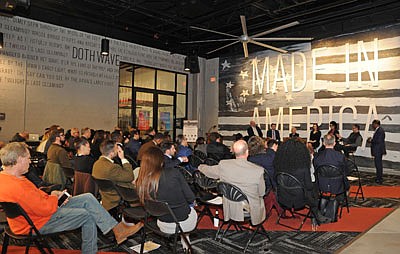“The Future Of Charm City” was a night of networking, collaboration and discussion with telecommunications giant AT&T and local tech hub Betamore that involved a panel of tech pioneers, creative entrepreneurs, community leaders and business executives who came together to discuss the future of technological innovation in Baltimore, and how the growing technology sector is affecting the region across different industries.
The event, presented by AT&T in conjunction with Betamore, was held on January 24, 2019 at the City Garage. Event attendees had the chance to get an up-close look at small cell equipment, which is paving the way for the next generation of mobile technology.
Panelists were Marc Blakeman, president of AT&T Mid-Atlantic (Maryland, Delaware, New Jersey, Pennsylvania, Virginia and Washington, D.C.); Bill Cole, president and CEO of the Baltimore Development Corporation; Ellen Hemmerly, Executive Director at bwtech at the University of Maryland Baltimore County Research and Technology Park; Greg Cangialosi, Chairman and Co-Founder of Betamore; Alysha January, influencer and blogger; and Heidi Klotzman, CEO of HeidnSeek Entertainment.
The panel discussion was moderated by Thiru Vignarajah, former Maryland deputy attorney general. He opened the discussion by highlighting the promise that Baltimore has despite its deplorable reputation.
“What we want to do tonight is to talk a little bit about how technology, in particular, is going to advance the future of Baltimore,” Vignarajah said.
“We talk a lot about what’s wrong with the city. What we’re going to do tonight is talk about what’s right, and what could set us on the path to becoming the 22nd-century city that Baltimore is destined to become.”
Moreover, the panelists shared their thoughts on the future of Baltimore’s purported burgeoning tech industry. Some of the topics discussed were how various sectors of the community will benefit from the expected technological advancements coming to the city, such as law enforcement, the transit system, education and job creation. Small-cell infrastructure was also a major point of emphasis.
Following the panel discussion was a brief Q&A session in which the audience asked questions concerning advancements in technology and the arts, in healthcare technology and small-cell technology’s impact on the city.
Small cells are small, unobtrusive equipment that can be placed onto existing infrastructure (light pole, building, etc.) and are vital components of the future of technology. According to the American Consumer Institute Center for Citizen Research, small-cell reforms and developments can lead to an estimated 6,427 jobs in Maryland along with a $9 billion Maryland Gross State Product.
A recent report by Technically Baltimore notes that over the next 10 years, AT&T plans to install thousands of small cells across Maryland. Antenna systems installed on light poles and buildings could help usher in 5G technology – a term used to describe the next generation of blazingly fast mobile networks beyond the 4G LTE mobile networks of today – which is already starting to appear in various locations around Maryland, Blakeman said.
Blakeman said Baltimore is at the precipice of a cybersecurity breakthrough, and expressed what importance that technological infrastructure will have for the city as 2020 approaches. He encouraged the audience to be ‘digitally responsible’ and that they have a role in building the infrastructural network that may revive Baltimore City.
“From AT&T’s perspective, there’s amazing things being done with technology today,” Blakeman said.
“This technology is only as good as the infrastructure that it rides on… So we’re really working on building up infrastructure here in Maryland and letting people know that we appreciate their help and making sure their voices get heard.”
Alysha January, also an activist passionate about creating equality, uses her social media platform to highlight small businesses in the city.
“I think it will definitely making people start thinking about how is this technology going to help change Baltimore and help us go into a more positive direction,” January said, explaining what she thought to be the significance of the panel discussion. She said she hopes the discussion impels the community to think of ways to use forthcoming technological advancements to ensure that less fortunate youth have equal opportunities.
Jermaine Gibbs was one of the several dozen audience members who appeared to be intrigued by the informative panel discussion and Q&A thereafter.
“I definitely learned about different technologies and I had no clue that the cybersecurity industry was so big in this area,” said Gibbs, a freelance photographer.
“Learning of all the different things that are coming to Baltimore and different opportunities — I’m hoping that these will create jobs, which will help take away some of the poverty, which will in turn take away some of the crime.”
